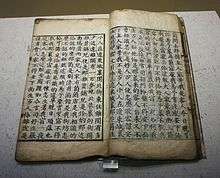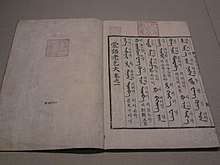Nogeoldae
The Nogeoldae (Chinese: 老乞大; pinyin: Lǎo Qǐdà; lit.: 'Old Cathayan') is a textbook of colloquial northern Chinese published in Korea in several editions from the 14th to 18th centuries. The book is an important source on both Late Middle Korean and the history of Mandarin Chinese. Later editions were translated into Manchu and Mongolian.
| Nogeoldae | |
 | |
| Korean name | |
|---|---|
| Hangul | 노걸대 |
| Hanja | 老乞大 |
| Revised Romanization | Nogeoldae |
| McCune–Reischauer | Nogŏltae |
Contents
The word Geoldae of the title, like the term Cathay, is a transcription of the Mongolian form of Khitan, a people who ruled northern China as the Liao dynasty (907–1125).[1] It became a common name throughout Asia for China and all things Chinese.[2] Here it means 'Chinese'.[3]
The book mainly consists of dialogs centered on a journey of a Korean merchant and his relatives to Beijing. It opens with the following lines:[3]
| 大哥你從那裏來 | "Elder brother, where do you come from?" |
| 我從高麗王京來 | "I come from Wangjing in Korea."[lower-alpha 1] |
| 如今那裏去 | "Where are you going presently?" |
| 我往北京去 | "I am going to Beijing."[lower-alpha 2] |
On the way they are joined by Chinese travelers. After arriving in Beijing, they sell Korean commodities and purchase goods to sell back in Korea. The book concludes with their departure from Beijing.
The book focuses on language used in travel, business, banquets, and medicine.[4] It also contains unique insights into life in Beijing, including the first instance of the word hutong (alley).[1]
Later editions are accompanied by Korean-language annotation (諺解 eonhae) interleaved with the text.[5] Below each Chinese character are written two transcriptions in Hangul: a "left reading" taken from the "popular readings" in Shin Suk-ju's 1455 dictionary, and a "right reading" reflecting contemporary pronunciation. Each Chinese sentence is followed by a colloquial Korean translation.[6][7]
Editions
Five editions of the book exist, as it was revised over the centuries to follow changes in the northern Chinese vernacular.[1]
The original Chinese edition seems have been written around the middle of the 14th century.[1] The Nogeoldae and a similar text, Bak Tongsa ("Pak the interpreter"), were very popular, and are mentioned in Korean records of 1426 as required texts for government translators.[8] An early 15th century copy discovered in Daegu in 1998 is believed to be close to the original version.[1] It includes valuable information on the colloquial Northern Chinese language of the Yuan dynasty, called Han'er speech (漢兒言語) in this book.
In 1480, the royal instructor ordered revisions of both textbooks to match the very different Middle Mandarin of the Ming dynasty.[9] A Korean scholar, Choe Sejin, wrote a guidebook based on this edition in 1507–17.[1][10] This edition is now conventionally called the Beonyeok Nogeoldae (飜譯老乞大 "New Translation of the 'Old Cathayan'") to distinguish it from the original.[11] The Korean versions of the dialogs are written in a colloquial style, giving unique insight into Late Middle Korean.[5]
A third edition, the Nogeoldae eonhae, was published in 1670 by the Bureau of Interpreters.[12] It has the same Chinese text as the Beonyeok Nogeoldae, but the right readings and translations were updated to contemporary Korean.[13][14]
During the Qing dynasty, the Chinese text was revised again as the Nogeoldae Sinseok (老乞大新釋 "New edition of the 'Old Cathayan'"), which was published in 1761.[1] A corresponding revised commentary, the Nogeoldae sinseok eonhae, was published in 1763 but is no longer extant.[13]
The Junggan Nogeoldae (重刊老乞大 "Reprinted 'Old Cathayan'") appeared in 1795, with a corresponding commentary Junggan Nogeoldae eonhae. Its Chinese text is less colloquial than the earlier versions.[1]
Translations

Translations of the Nogeoldae into other languages were also published by the Bureau of Interpreters. The Cheong-eo Nogeoldae (淸語老乞大 "Manchu 'Old Cathayan'") includes Manchu text along with Hangul pronunciation and Korean translations. It was written by Choe Hutaek (崔厚澤) and others and published in 1704 and revised in 1765. I Choedae (李最大) made a Mongolian edition called the Mong-eo Nogeoldae (蒙語老乞大 "Mongolian 'Old Cathayan'") that was published in 1741 and revised in 1766 and 1790.[15] A Japanese translation was also published, but is no longer extant.[16]
Notes
- The city of Kaesong is here called Wangjing, the "Royal Capital" (王京, wang gyeong), as opposed to the Imperial Capital.
- In earlier versions of the text, Beijing is called by its Mongol name, Dadu.
References
- Wilkinson (2013), p. 786.
- Rimsky-Korsakoff Dyer (1983), pp. 4–5.
- Wadley (1987), p. 13.
- Sun (1996), pp. 9–10.
- Lee & Ramsey (2011), p. 100.
- Kim (1991), pp. 15–16.
- Kim (1989), pp. 41–42.
- Sun (1996), p. 8.
- Sun (1996), pp. 8–9.
- Lee & Ramsey (2011), pp. 111–112.
- Kim (1989), p. 40.
- Lee & Ramsey (2011), p. 245.
- Kim (1989), p. 41.
- Kim (1991), p. 16.
- Lee & Ramsey (2011), p. 248.
- Kornicki (2018), p. 85.
Works cited
- Kim, Kwangjo (1991), A phonological study of Middle Mandarin: reflected in Korean sources of the mid-15th and early 16th centuries (PhD thesis), University of Washington, OCLC 24343149.
- Kim, Youngman (1989), Middle Mandarin Phonology: A Study Based on Korean Data (PhD thesis), Ohio State University, OCLC 753733450.
- Kornicki, Peter Francis (2018), Languages, scripts, and Chinese texts in East Asia, Oxford University Press, ISBN 978-0-198-79782-1.
- Lee, Ki-Moon; Ramsey, S. Robert (2011), A History of the Korean Language, Cambridge University Press, ISBN 978-1-139-49448-9.
- Rimsky-Korsakoff Dyer, Svetlana (1983), Grammatical analysis of the Lao Ch'i-ta: with an English translation of the Chinese text, Faculty of Asian Studies, Australian National University, ISBN 978-0-909879-18-1.
- Sun, Chaofen (1996), Word-order Change and Grammaticalization in the History of Chinese, Stanford University Press, ISBN 978-0-8047-2418-0.
- Wadley, Stephen Alexander (1987), A translation of the "Lao Qida" and investigation into certain of its syntactic structures (PhD thesis), University of Washington, OCLC 15926747.
- Wilkinson, Endymion (2013), Chinese History: A New Manual, Cambridge, MA: Harvard University Press, ISBN 978-0-674-06715-8.
Further reading
- Song, Ki-Joong (1982), "The Study of Foreign Languages in the Yi Dynasty (1392–1910): Part Three, Books for the Study of Foreign Languages (2)", Journal of Social Sciences and Humanities, Seoul: Center for Korean Research, 56: 1–57.
External links


- Joseon dynasty texts at the Academy of Korean Studies, including Beonyeok Nogeoldae, Nogeoldae eonhae, Cheong-eo Nogeoldae, Mong-eo Nogeoldae and Junggan Nogeoldae.
- Texts at the Internet Archive:
- Text based on the Nogeoldae eonhae